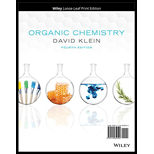
(a)
Interpretation:
To obtain the desired product, the reactant molecule must undergo a Grignard reaction and needs a protecting group to facilitate the reaction to occur. The protecting reagent is to be determined.
Concept Introduction:
Normally, an aryl bromide can directly be converted to arylmagnesium halide by reaction with Magnesium. But in this case, there is the presence of an acidic alcoholic group which can hinder the formation of Grignard reagent, which is a strong base. To prevent this, an
After the formation of the Grignard reagent, it can be coupled with a suitable reactant, followed by deprotection, to obtain the final product.
(b)
Interpretation:
To obtain the desired product, the reactant molecule has to undergo a Grignard reaction and needs a protecting group to facilitate the reaction to occur. The protecting group is to be determined.
Concept Introduction:
Normally, an aryl bromide can directly be converted to arylmagnesium halide by reaction with Magnesium. But in this case, there is the presence of an acidic alcoholic group which can hinder the formation of Grignard reagent, which is a strong base. To prevent this, an
After the formation of the Grignard reagent, it can be coupled with a suitable reactant, followed by deprotection, to obtain the final product.
Want to see the full answer?
Check out a sample textbook solution
Chapter 12 Solutions
ORGANIC CHEMISTRY-PRINT COMPANION (LL)
- Determine if the following salt is neutral, acidic or basic. If acidic or basic, write the appropriate equilibrium equation for the acid or base that exists when the salt is dissolved in aqueous solution. If neutral, simply write only NR. Be sure to include the proper phases for all species within the reaction. NaN₃arrow_forwardCan I please get help with this?arrow_forwardCan I please get help with this?arrow_forward
- Use the Henderson-Hasselbalch equation to calculate pH of a buffer containing 0.050M benzoic acidand 0.150M sodium benzoate. The Ka of benzoic acid is 6.5 x 10-5arrow_forwardA. Draw the structure of each of the following alcohols. Then draw and name the product you would expect to produce by the oxidation of each. a. 4-Methyl-2-heptanol b. 3,4-Dimethyl-1-pentanol c. 4-Ethyl-2-heptanol d. 5,7-Dichloro-3-heptanolarrow_forwardWhat is the pH of a 1.0 L buffer made with 0.300 mol of HF (Ka = 6.8 × 10⁻⁴) and 0.200 mol of NaF to which 0.160 mol of NaOH were added?arrow_forward
- Can I please get help with this.arrow_forwardDetermine if the following salt is neutral, acidic or basic. If acidic or basic, write the appropriate equilibrium equation for the acid or base that exists when the salt is dissolved in aqueous solution. If neutral, simply write only NR. Be sure to include the proper phases for all species within the reaction. N₂H₅ClO₄arrow_forwardPlease help me with identifying these.arrow_forward
 Organic ChemistryChemistryISBN:9781305580350Author:William H. Brown, Brent L. Iverson, Eric Anslyn, Christopher S. FootePublisher:Cengage Learning
Organic ChemistryChemistryISBN:9781305580350Author:William H. Brown, Brent L. Iverson, Eric Anslyn, Christopher S. FootePublisher:Cengage Learning
 Introduction to General, Organic and BiochemistryChemistryISBN:9781285869759Author:Frederick A. Bettelheim, William H. Brown, Mary K. Campbell, Shawn O. Farrell, Omar TorresPublisher:Cengage Learning
Introduction to General, Organic and BiochemistryChemistryISBN:9781285869759Author:Frederick A. Bettelheim, William H. Brown, Mary K. Campbell, Shawn O. Farrell, Omar TorresPublisher:Cengage Learning


